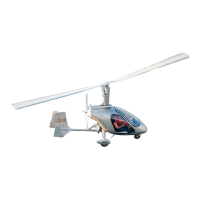
Do you have a question about the Magni Gyro M-24C Orion and is the answer not in the manual?
| Brand | Magni Gyro |
|---|---|
| Model | M-24C Orion |
| Category | Aircrafts |
| Language | English |
Defines the manual's purpose for safe and effective gyroplane operation.
Outlines allowed manoeuvres and operating limitations for the gyroplane.
Describes the manual's structure, divided into sections for clarity.
Contains indexed procedures and clarifications for flight operations.
Explains symbols and terminology used in the manual for better understanding.
Provides definitions for common abbreviations used throughout the flight manual.
Describes the M-24C Orion gyroplane's structure, configuration, and primary features.
Specifies the physical dimensions of the gyroplane, including rotor diameter and height.
Provides essential technical specifications: weights, performance, fuel, and engine data.
Details the location and contents of the manufacturer's identification placard.
Lists and illustrates the main components of the gyroplane for identification.
Detailed overview of the cockpit instruments, controls, and their arrangement.
Comprehensive guide to the aircraft's instruments and operational controls.
Describes primary flight instruments like compass, ASI, and altimeter.
Details warning lights, switches, and gauges on the central console.
Explains the function and operation of the throttle lever for engine power control.
Describes how rudder pedals control direction and nose wheel steering.
Covers controls for rotor operation, including control stick and prerotation.
Information on the type and function of the gyroplane's safety belts.
Outlines the operational limits to be observed during gyroplane use.
Specifies the required crew number for all flights.
Details engine power and RPM limits for continuous and maximum operation.
Procedures and warnings for exceeding the engine's maximum RPM.
Defines Never Exceed (Vne) and Normal Operating (Vno) speeds for safe flight.
Prohibits aerobatic and low 'g' manoeuvres, specifies limits.
Outlines pilot weight and loading limits to maintain CG within safe parameters.
Specifies maximum take-off and landing weights for the gyroplane.
Discusses potential electrical system overloading and normal procedures.
Introduction to take-off, flight, and landing procedures covered in the chapter.
Refers to appendix for flight planning reference data.
Information on takeoff and landing data (TOLD) is contained in the APPENDIX.
Refers to Section 3 and CG Data APPENDIX for weight and balance limits.
Mentions a concise pilot checklist supplied as a separate document.
Essential checks performed before the first flight of the day.
Step-by-step guide for checking instruments, pedals, sticks, and cockpit interior.
Procedure for performing a walk-round check of the gyroplane's exterior.
Instructions for inspecting the engine compartment on the right side.
Instructions for inspecting the engine compartment on the left side.
Important considerations and recommendations for engine operation.
Detailed procedure for starting the engine, including safety warnings.
Procedures and warnings for taxiing the gyroplane to the holding point.
Describes the purpose and execution of taxiing the gyroplane to the holding point.
Checklist of operations to perform before entering the runway.
Procedure for engaging the rotor prerotation system before takeoff.
Procedure for becoming airborne and initial climb after takeoff.
Guidance on performing takeoff procedures in crosswind conditions.
Describes various in-flight manoeuvres like climb, descent, and level flight.
Procedures for gaining altitude, including best climb speeds.
How to maintain constant speed and altitude during level flight.
Technique for executing level turns with bank angles less than 15 degrees.
Procedures for non-standard flight regimes and manoeuvres.
Procedure for flying at reduced speeds near the power curve.
Describes the procedures for various landing scenarios.
Steps to take before entering the circuit for landing.
Detailed procedure for executing a normal landing.
Steps for safely stopping the engine after landing.
Importance of correct maintenance for safe flight operations.
Introduction to managing emergency situations safely.
Procedures requiring rapid, instinctive response without checklists.
Actions to take in case of fire during engine starting.
Decision-making process for aborting or continuing takeoff during an emergency.
Procedures for handling engine or electrical fires during flight.
Recommended actions for engine failure during taxi, takeoff, or in flight.
Procedure for attempting to restart the engine while in flight.
Safety guidelines for occupants when abandoning the aircraft in an emergency.
Explanation of warning lights and their implications for flight safety.
Procedures for flying in adverse weather conditions are described.
Guidelines for flying in or avoiding turbulence and storms.
Prohibition of flight in icing conditions and guidance for rain flying.
Precautions for landing on snowy, icy, or wet runways.
Recommendations for operating the gyroplane in varying temperature conditions.
Advice for starting and operating the gyroplane in low temperatures.
Recommendations for operating the gyroplane in high temperatures.
Provides information on approved fuels and lubricants for the gyroplane.
Lists approved fuels and usage notes for the M24C.
Recommendations for engine oil types and specifications.
Reference to the document detailing the ordinary maintenance schedule.
Graphs showing engine performance, torque, and fuel consumption.
Graphs showing engine performance versus speed and power.
Graphs illustrating engine torque versus speed.
Graph showing fuel consumption versus engine speed.
Contains data related to the Centre of Gravity (CG) of the gyroplane.
Lists performance data such as speeds, distances, climb rates, and crosswind limits.
Presents the Height-Velocity diagram for the gyroplane.
Specifies limitations for flight manoeuvres, including bank angle and prohibited actions.
